We’re somewhere in the hills outside Seattle, Washington. I’d tell you where, exactly…but then I’d have to kill you.
This is golden chanterelle season. We hike through a mousse of gray fog, into a forest of Douglas fir trees. In the Pacific Northwest, chanterelles have a mycorrhizal relationship with Douglas firs; the mushrooms feed on sugars from the tree and the tree, in turn, provides nutrients for the mushrooms (on the east coast and in California, the mushrooms tend to grow under oaks).
Regardless of the type of host, chanterelles are only found at the base of live trees. We learn this from our guide, Matt Stoecker, an amateur mycologist, who has been foraging in the Pacific Northwest for 21 years. He learned about mushrooms as an undergraduate at Oberlin College, from Dr. David Miller. He also credits a large amount of outside reading and in-the-field experience (literally), for much of his knowledge.
As we climb deeper into the steep forest, Matt tells us this is a fairly popular spot for professional mushroom hunters. He stops and looks around, then lays his gear on the dark moss and rotting underbrush. We do the same. He sweeps a few sticks and bark away and points out a manilla-colored Golden Chanterelle (C. cibarius) stump about half an inch in both height and diameter. “People have been through here within the last day or two,” he says, and goes on to show us where the mushroom was sliced near the base.
He seems slightly down about it, but assures us we won’t go home empty-handed. “We’re getting someone’s sloppy seconds, but there’s plenty for everyone.” He starts to divvy up the equipment he’s brought for today’s expedition. “This used to be my very own spot, but then commercial pickers discovered it and my yields went down. But that just means I wasn’t getting 15 pounds every time.”
Bagging the Gold
Between us, we have bags and bags of all shapes and sizes. We have an optimistic number of bags. I can’t imagine how we’ll fill five grocery sacks from a freshly-harvested piece of land – but I’m happy to be proven wrong. Matt pulls out a kitchen knife for each of us and hands them around. As we wander off in different directions – everyone staring at the damp ground while stumbling uphill with blade in hand – it occurs to me that mycological mistaken identity might not be the only cause of death in these sorts of adventures.
As we wander off in different directions – everyone staring at the damp ground while stumbling uphill with blade in hand – it occurs to me that mycological mistaken identity might not be the only cause of death in these sorts of adventures.
Matt has already debriefed us on what to look for – and what not to look for – in this wild, fungal garden. Chanterelles are a good starter ‘shroom: They’re one of the easiest to identify, their golden-yellow color has a tendency to stand out against the dark and mossy environs, and the more nefarious chanterelle doppelgangers are unlikely to do more than taste bad (False Chanterelle, Hygrophoropsis aurantiaca) or make you temporarily ill (the Jack-O-Lantern mushroom, Omphalotus olearius).
Most chanterelles are a sort of bright egg yolk-yellow in color. The underside reveals fine gills that begin right before the stem (stipe) curves up toward the cap; the cap and stipe are continuous, not separate as with some other mushroom species. The tops are always smooth and matte. Juveniles appear to have a round cap (the wavy edges have yet to unfurl). Mature chanterelles are famous for their funnel or trumpet shape, with an undulating margin, and can grow as large as 5 inches across, with a proportional stipe. Despite their sunny color, the flesh inside is beigey-white. The Golden Chanterelles we’re hunting today always, always, always grow out of the ground.
It takes me awhile to finally spot one on my own. Matt advised me to just “take a few steps and look.” I tried this, but while everyone else was bobbing productively through the woods, I’d been coming up empty-handed. Matt comforted that all I had to do was “get that visual filter going.” He assured me that once I saw one, I’d suddenly see more, everywhere.
I send up a passing prayer to heaven that what I’m hearing is just a deer – or, at the very least, something that isn’t hungry – and go right on picking.
For the most part, he was right.
I stop and refocus, looking at the ground with a slightly softer gaze, and spot a chanterelle immediately. And as soon as I see that first orange trumpet sticking out of the ground, the forest is damn near filled with them. There are bears in these woods, and I’m vaguely conscious of the snaps and cracks of something weighty moving through the trees, but I’m obsessed with hunting these mushrooms, and – like Gretel on her own trail – I keep getting drawn further and further into the woods. I send up a passing prayer to heaven that what I’m hearing is just a deer – or, at the very least, something that isn’t hungry – and go right on picking.
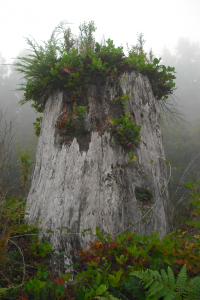
Golden chanterelles depend on Douglas firs to grow and so far no one has been able to culivate them domestically.
We never actually see a bear, deer or even another human, although there very well could be several of the latter, combing through the trees nearby. Our little bounty can fetch between $20 – $30 per pound, retail, and this is the only way to harvest them: in the wild. Despite scientists’ best efforts, chanterelles cannot be cultivated. “The best you can do is own a big Douglas fir and hope some grow,” Matt half-jokes. They need the symbiosis of a living tree, and, perhaps, a little magic. The giant root system (mycelium) is enormous, and it’s unclear just how far it reaches or where it begins. The mushroom, itself, is only the fruiting body of the fungus; just the tip of a massive and complicated proverbial iceberg beneath the soil.
I find the most clusters in little fields of moss and half-buried under old tree debris. Sometimes I’m fooled by a patch of orange lichen; every once-in-awhile, my gorgeous orange discovery turns out to be changing color, with soft, creamy patches. “That means the Chanterelle is starting to digest itself,” Matt explains. “No good.”
The general – and smart – wisdom is to avoid any mushroom one has doubts about. As we wander through the woods, Matt somewhat gleefully rattles off idioms he’s picked up from David Arora’s book, Mushrooms Demystified: A Comprehensive Guide to the Fleshy Fungi. “Better kicked than picked,” “Better punted than hunted,” “Better eyed than fried,” “Better smashed than stashed.”
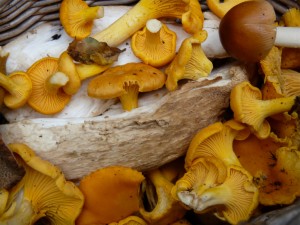
The thrill of the hunt includes avoiding the fakes. Luckily most chanterelle lookalikes are not lethal. This haul is the real deal. (Photo © Stacia Briggs)
These sayings are funny, but mushroom poisonings are no joke. According to the 2011 NAMA Toxicology Committee Report on North American Mushroom Poisonings, 117 people were seriously sickened by mushrooms, with two fatalities and two kidney transplants. “Partly as a result of a record mushroom season in eastern North America, the reports of poisonings due to mushrooms was up in 2011.” In addition to the human poisonings, the report also listed the illnesses of “27 dogs with 13 deaths, and 3 rabbits intoxicated.” (The rabbit intoxications are also no joke…at least to some people).
The Mother Lode
In the end, we’re taking home about five pounds of fungal gold. As we drive through the lifting fog, into the sunshine and back into the city, Matt tells us how to prepare our bounty.
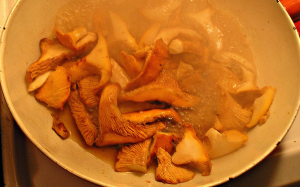
A dry saute in a hot oil-free pan causes the chanterelles to render lots of water. (This can be saved for flavoring.) Photo © Roman Eye
While chanterelles are fine to eat raw, they tend to taste better when cooked or pickled. Before doing anything with them, he recommends giving them a dry saute: preheat a pan with salt, on high, then add the chanterelles, chopped or torn into chunks, and stir constantly. The salt draws out the water, concentrates the flavor and improves the mushrooms’ firmness. Once they’ve stopped giving up liquid, Matt rinses away the excess salt, then sautes again in butter, adds to sauce, or freezes.
If sauteed with onions before freezing, one has a ready-made base for an assortment of mushroom dishes. While they don’t have to be sauteed prior to freezing, if chanterelles are frozen together their inherent high water content will result in a giant mushroomy ice clump. They can also be dried, but the resulting leathery texture makes the reconstituted mushrooms best suited for soups or stews.
We’re cooking over pound of them for dinner tonight. I’d tell you what we’re making, but then I’d have to…well, you know. Let’s just continue to enjoy the mystery.
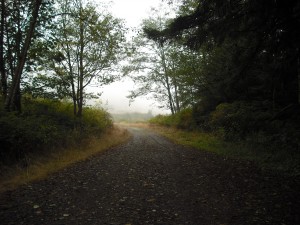
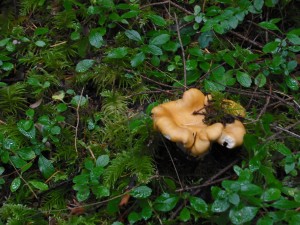
Hunting Chanterelles in the Pacific Northwest: (Banner photo © tonx) We’re somewhere in the hills … http://t.co/C1awvIIi via @toquemag